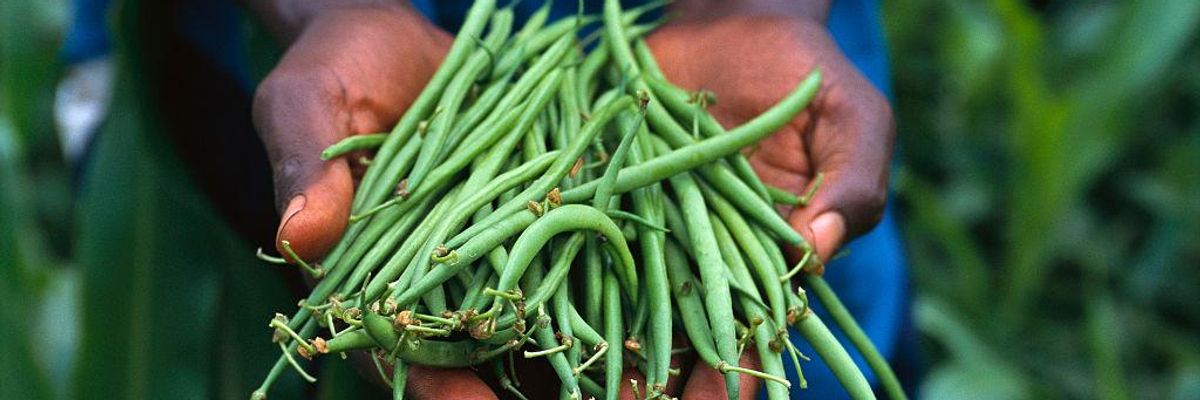This year climate finance is all the talk. As the UN Climate Conference in Bonn wraps up and the stage is set for COP29 later this year, expectations are high for governments to agree on a new climate finance package that will tackle the worsening climate and ecological crises.
In many countries, food production is the climate frontline. Nearly 95% of nationally determined contributions (NDCs) include adaptation and mitigation actions in the agriculture sector yet fail to address the full food system.
It only takes one climate disaster—a drought, flood or heatwave—for entire villages to spiral into debt, poverty and hunger, impacting regional food systems and economies.
Responding to the climate and nature crises, will require a transformation of food systems backed by a rapid redirection of funds to flip agriculture from being part of the problem to offering solutions. Last year, 25 philanthropies—coordinated by the Global Alliance for the Future of Food—called for a tenfold increase in funding towards agroecological and regenerative approaches. Philanthropy, multilateral and bilateral organizations and governments must scale and align funding to catalyze a transition to 50% regenerative and agroecological systems by 2040 and to ensure all agriculture and food systems are transitioning by 2050. Read the full report.
Right now, industrialized food systems account for one-third of greenhouse gas emissions and at least 15% of fossil fuel use. This broken system—the ‘true cost’ of food production—comes at a staggering $12 trillion a year, according to the FAOlast year. It manifests in hefty medical bills and the degradation of our soil, air, water, and biodiversity.
In this decisive decade, the way we grow, consume and package our food cannot be ignored or siloed in an all-hands-on-deck effort to meet our climate and biodiversity goals.
Moving away from a fossil-fuel based food system will not be cheap. It requires unlocking $250-430 billion per year, but this is in fact cheaper— than what is currently spent each year on harmful agricultural subsidies ($635 billion each year) and a fraction of the true cost of current food production.
Right now, investments into agroecology and regenerative approaches by the philanthropic, public, and the private sectors is estimated to be just $44 billion per year.
As representatives of leading philanthropy we are committed to scaling up funding into agroecological and regenerative approaches as a means to leverage existing policies that address the challenges of climate change and biodiversity loss. By embracing agroecology, communities have better control over the food they produce to future-proof their livelihoods and to make decisions to strengthen food sovereignty based on locally-tested solutions and knowledge.
There is a political appetite to make this transition and intergrate agroecological approaches into policy.
For example, the Tanzania government has worked with national civil society organizations to develop a National Ecological Organic Agriculture Strategy and implementation plan. Similar agroecology strategies are being developed in other Eastern African countries, like Kenya, Uganda and Rwanda. Priority actions include making agroecological and bio-inputs available, ensuring avenues for knowledge exchange and skills-sharing among farmers, expanding market access for food producers, mainstreaming village land use planning, fostering investments across the value chain, and supporting coordination, capacity building and governance at all levels.
And they’re not alone. In the Andes, smallholder farmers are stewarding thousands of varieties of native potatoes, preserving their cultural heritage, supporting their livelihoods and providing food for domestic consumption while also growing new markets in collaboration with researchers, civil society experts and other food system actors. Mountains are unique ecosystems, many of which are biodiversity hotspots and home to Indigenous Peoples. Mountain ecosystems are generally forgotten in national and international discussions, but are critical to biodiversity and resilience, especially in the face of climate change. The Andes are also not an island—they are critical for the existence of the Amazon and in turn the Amazon has a dramatic influence on the climate of the Andes, highlighting the interconnectedness that very often is broken by industrial agriculture. Support for Indigenous and agroecological approaches is vital to sustain the important contributions made by smallholder farmers in building thriving and sustainable local and regional food economies.
In this decisive decade, the way we grow, consume and package our food cannot be ignored or siloed in an all-hands-on-deck effort to meet our climate and biodiversity goals. It’s a race against time and we urgently need to see the money—in the tens of billions of dollars—move towards real solutions, particularly where policies are ready to be turned into action.
We are calling on governments, the private sector and other philanthropic partners to join us in this initiative and commit to scaling up their investments so communities, Indigenous Peoples and the health and the future of all living beings and the planet are at the center of our financial decisions.
